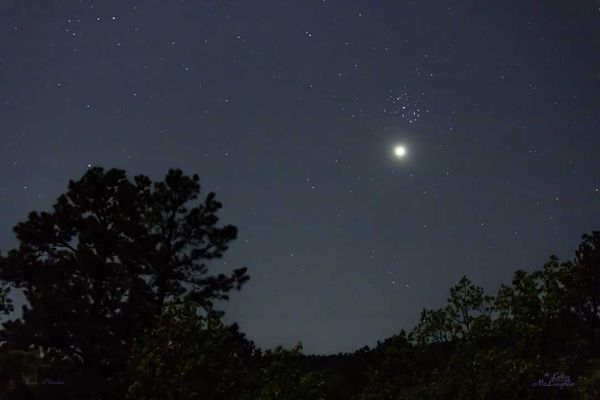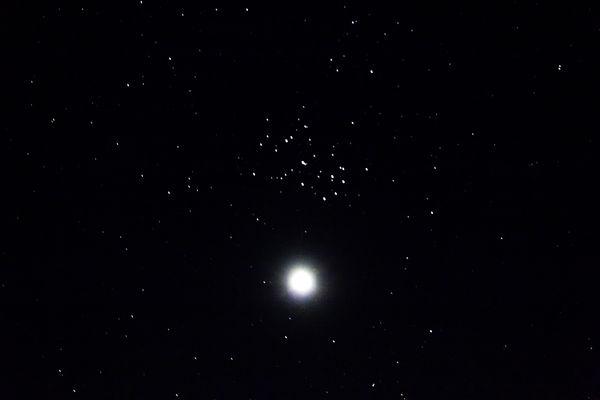Venus-Pleiades last night
Apr 2, 2012 08:08:22 #
We have rain forecast for tomorrow evening, so I look this last night. Canon t2i w/ ef-s 55-250 4-5.6 IS at 55mm 6 sec. ISO 1600. The 6 sec. is to long, should have been around 4 sec. for I have star trails

Apr 2, 2012 11:23:50 #
tirehouse,
Thanks for the lessons and the nice shot. Always a fascination with the stars.
Lee
Thanks for the lessons and the nice shot. Always a fascination with the stars.
Lee
Apr 2, 2012 11:53:08 #
Welcome to UHH.
Really like your composition.
Tried to check out your website but it is "not available"
Really like your composition.
Tried to check out your website but it is "not available"
Apr 2, 2012 11:54:27 #
Apr 2, 2012 12:10:35 #
Apr 2, 2012 12:20:35 #
Thanks. Here is another one shot at 154mm f 5.6 6 sec at ISO 800. Still a little star trail. Probably 4 or 5 sec should do.

Apr 2, 2012 12:22:28 #
Thanks. I've only been doing this for over 50 years and still have gobs to learn.
genepoole wrote:
tirehouse,
Thanks for the lessons and the nice shot. Always a fascination with the stars.
Lee
Thanks for the lessons and the nice shot. Always a fascination with the stars.
Lee
Apr 3, 2012 10:24:06 #
Lucian
Loc: From Wales, living in Ohio
next time take a big search light type light and do a little light painting on your trees at the base there, it will give added dimension to your shots and is fun trying lighting from different directions to enhance your lovely star shots.
Apr 3, 2012 10:42:55 #
Lucian wrote:
next time take a big search light type light and do a little light painting on your trees at the base there, it will give added dimension to your shots and is fun trying lighting from different directions to enhance your lovely star shots.
It was pretty light out there with the moon. I'll try the light idea next time, although it'll be rough with no power. I live on battery power.. Nearest power line is 2 miles away.
Apr 3, 2012 11:53:37 #
Nice shot and the trailing isn't really objectionable.
You can easily calculate an approximation of the length of a star trail by:
Trail Length = focal length in mm * Exposure in seconds * .0007
So the trail for your 6 second shot at 154mm is .065mm or 65 microns.
You can then calculate how many pixels that represents based on your pixel pitch. It looks like the T2i has a pixel size of 4.5 microns per pixel, so the star image should cover (ideally) about 14 pixels. This isn't including diffraction or atmospheric tremors.
Finally, this is for a star trail on the celestial equator where the apparent motion of the stars is greatest. You could include the cosine of the declination (of memory serves... which it probably doesn't!) in your calculation. But the equator is the worst case. Shooting north or south of the celestial equator results in even shorter trails.
Probably more than you ever wanted to know about photographing star trails!
You can easily calculate an approximation of the length of a star trail by:
Trail Length = focal length in mm * Exposure in seconds * .0007
So the trail for your 6 second shot at 154mm is .065mm or 65 microns.
You can then calculate how many pixels that represents based on your pixel pitch. It looks like the T2i has a pixel size of 4.5 microns per pixel, so the star image should cover (ideally) about 14 pixels. This isn't including diffraction or atmospheric tremors.
Finally, this is for a star trail on the celestial equator where the apparent motion of the stars is greatest. You could include the cosine of the declination (of memory serves... which it probably doesn't!) in your calculation. But the equator is the worst case. Shooting north or south of the celestial equator results in even shorter trails.
Probably more than you ever wanted to know about photographing star trails!
Apr 3, 2012 11:56:16 #
Apr 3, 2012 12:02:19 #
Really thanks ngc1514. I'm not into astrophotography that much but I thought this was a good subject to shoot. Thanks Leroy
tirehouse wrote:
quote=ngc1514 Nice shot and the trailing isn't re... (show quote)
Apr 3, 2012 13:44:34 #
No problem, tirehouse. The formula may interest others doing star trails.
Apr 3, 2012 15:06:23 #
Lucian
Loc: From Wales, living in Ohio
Tirehouse... I meant the battery type that you keep in your car usually about 1-2 million candle power not a plug in the wall model.
Painting with light from off to the side on those trees will give a very different look that just allowing ambient light to illuminate the trees.
Painting with light from off to the side on those trees will give a very different look that just allowing ambient light to illuminate the trees.
Apr 3, 2012 16:40:03 #
ngc1514 wrote:
That's the same thing they said on the "Big Bang Theory". What year did you graduate from MIT?? Just kidding, interesting stuff if I knew what you were talking about. Eight years in college and not once did they bring this up---damned state schools.......Nice shot and the trailing isn't really objectiona... (show quote)
If you want to reply, then register here. Registration is free and your account is created instantly, so you can post right away.





